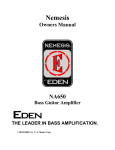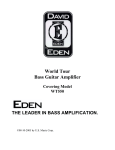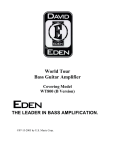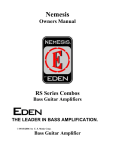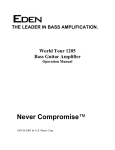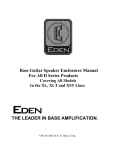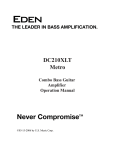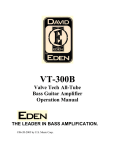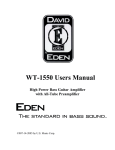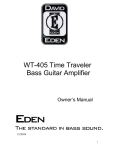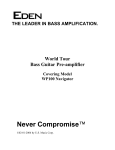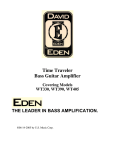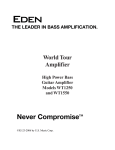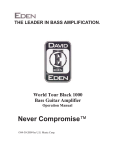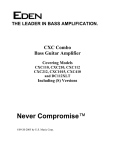Download Eden Nemesis N8 Operating instructions
Transcript
Nemesis Owners Manual N8 Bass Guitar Amplifier THE LEADER IN BASS AMPLIFICATION. © 02/06/2006 by U. S. Music Corp. Bass Guitar Amplifier N8 OPERATION MANUAL Publishing Date 02-06-2006 FOREWORD Congratulations on the purchase of your new Nemesis N8 Bass Guitar amplifier. All of us at Eden are totally committed to providing you with the very best bass guitar systems in their class. Our goals are to offer you the outstanding performance quality of a top-notch, professional bass amplification system at a reasonable price point, and to make Nemesis amplifiers the most musical and reliable Bass amplifiers available. This manual will cover domestic and international versions of the N8 Combo Amplifier. The N8 delivers 40 watts RMS output @ 8 Ohms, with +3dB of headroom. This amplifier also features a passive cooling system. You have purchased what we feel is one of the finest bass amplifiers in its class. The pre-amplifier section features a gentle auto-compression circuit to protect the speaker. The cabinet is made of AA void-free plywood to withstand years of use. The Nemesis line of amplifiers is the result of our research and development in combining high performance and compact size. Just as a skilled craftsman needs good quality tools that won't let him down on the job, so does a good musician. We hope you enjoy the tool we’ve created for you. Have fun; play low! Please read this manual in its entirety before operating your new amplifier. Failure to do so could result in misuse or damage. We’ve taken the time to write it, which was a lot longer than the time it will take for you to read it. Help us help you by taking a few moments to learn how to properly use your new amp. You’ll be glad you did! 2 CAUTION! Your ears are your most important piece of equipment. Unfortunately, they cannot be replaced as easily as your other gear. Please take the following warning seriously. This product, when used in combination with loudspeakers and/or additional amplification may be capable of producing sound levels that could cause permanent hearing loss. DO NOT operate at high volume levels or at a level that is uncomfortable. If you experience any discomfort or ringing in the ears or suspect hearing loss, you should consult an audiologist. Thank you for your purchase of an Eden bass guitar product. This unit has been designed and constructed to give you years of trouble-free service. Please take the time to review this manual and to send in your warranty registration card. 3 FRONT PANEL FEATURES Input Jacks – Designed to accept a standard ¼ inch mono phone plug. For best results use a high quality shielded cable to connect your instrument to the amplifier. Two inputs are provided – one each for active and passive basses. If your bass has a battery, use the active input. NOTE: Batteries do wear out. So it’s a good idea to check the battery in your bass before using your amp. Then, check it regularly (monthly) to make sure it’s still good. Gain Control – Regulates the first gain stage of the preamplifier and controls the amount of signal available to the system. Three Band Tone Controls – Divides the audio spectrum into three bands: Bass, Mid, and Treble. The Bass and Treble controls are shelving type filters. The Mid control is a band pass type filter. These controls give you a broad general control of the tone shaping. Effects Loop – If you want to use outboard effects processors, use these jacks to SEND to and RETURN from your effects. This loop is for use with “rack mount” effects only. If you are using “stomp box” style boxes, plug your bass into the effects box, and then from there into the Input. Master Volume – Controls the main stage sound level and the Head Phone outputs. Headphone Jack – Accepts a standard ¼ inch stereo or mono headphone plug. It can also be used as a Master Output send to slave another amplifier. DC Indicator – When lit, this blue LED shows the power supply is operating, and your amplifier is ready to use. Mains On/Off Switch – This switch turns the system power ON or OFF. 4 BACK PANEL FEATURES Amplifier Power Rating: RMS output: 40 Watts @ 4 Ohms Fuse Holder – to replace the fuse, use a small screwdriver or coin to rotate the fuse holder. Remove the holder and replace the fuse with the correct value fuse. USE ONLY THE SAME SIZE AND TYPE FOR REPLACMENT. Using a fuse with a different rating than specified is a VERY BAD THING and can cause damage to your amplifier. All models are set up to operate properly in the country of sale. It is NOT possible to reconfigure your unit to operate in other countries. Fuse Requirements: USA @ 120 Volts /60 HZ – 2 Amps, 5 x 20 mm GMC/T/slow blow Europe @ 240 Volts/50 Hz – 1 Amps, 5 x 20 mm GMC/T/slow blow IMPORTANT NOTE: Always use slow blow or time delay type fuses. Do not use fast blow fuses. Power Cord – OK, this should be obvious. Plug this cord into a wall outlet. Never, and we mean NEVER, use a ground lift or remove the third prong of the plug. Disconnecting the ground from your unit can significantly increase your risk of injury. Removing the third prong from your plug will also immediately void your warranty. You have now been warned. Cooling System – Your amplifier features a passive cooling system, which operates automatically. IMPORTANT NOTE: Excessive heat is a Very Bad Thing and can result in severe damage to your amplifier. DO NOT cover the ventilation holes on the back of your amp, as this will cause your amplifier to overheat. Doing so will immediately void your warranty! 5 OPERATING INSTRUCTIONS Mechanical and Thermal Issues – During operation, your amplifier should always be placed away from sources of moisture or heat. Care should be taken not to obstruct the ventilation holes on the back of the unit. Electrical Connection – The N8 requires a properly grounded AC connection to operate safely and efficiently. Connections – All instrument-level input connections (everything but the speakers) should be made with high quality shielded cables. The use of speaker cables for input connections will result in excess noise. INITIAL SET UP As bassists, each of us has in our head a concept of our perfect sound. Eden amplifiers are designed to help you easily achieve the sound you hear inside you. However, it’s a multi-step process as explained below. In order to ensure the ultimate in tone, it’s important to follow the procedure outlined below. Don’t skip steps; don’t jump around. Yes, this may take a minute or two, but the work is well worth it. Once they’ve done it a few times, most users can do it time and again in about a minute. IMPORTANT NOTE: Before you plug in your unit for the first time, please do the following things. First, turn the power switch to the OFF position. Check the back of your unit for the correct voltage notation for your country of operation. Once you’ve ensured correct voltage, set the Master Volume control to it’s minimum position (full counter-clockwise). Set the tone controls to the center position (12:00 or 0). Set the Input Gain control to the minimum (fully counter-clockwise). This will set your amplifier up flat. Double check to make certain your amplifier is set for the correct voltage in your country. Double check that all connections are correct. 6 Turn On – Once you’ve completed the steps above, you can plug in your bass and turn on the unit (plug it in first, ok?) and let’s get started. We recommend turning your system on with the Master Volume control set to its minimum position. This will prevent any unexpected signal from being sent to your speakers. Once the unit is on, set the Master Volume to about 9:00 on a clock face. (By the way, we use a clock face to tell you where to set controls. We’re talking about an old-style clock here. You know, one with hands.) Setting Your Level – Remember, begin with the Input Gain completely OFF – fully counter-clockwise. All EQ should be set flat, that is, at 12:00 – straight up. While playing your lowest note (or loudest), slowly turn the Input Gain to approximately 12:00 or 1:00. You can go higher if needed, but you should not hear any distortion from the amplifier. The idea here is to set the Input Gain as high as possible without any distortion. This will give you the best signal through the rest of the amplifier. Once you have properly set your Input Gain, turn the Master Volume up to a comfortable listening level and proceed with the rest of the setup process. SETTING YOUR EQ The frequencies that you’ll need to boost or cut are dependent upon your instrument and your individual playing style. Extreme settings of boost or cut are unlikely to be necessary or helpful. Using the EQ Controls – Before you begin to twiddle knobs, let’s talk about a few things. Excessive boosting of one or more EQ frequencies may cause an overload in the EQ section. This is a Very Bad Thing and needs to be corrected immediately. Remember, too, that our EQ controls are passive (to give you a great oldschool sound) but are meant to turn both ways – not just UP! This means that you can enhance a certain frequency spectrum either by boosting that frequency or by cutting the adjacent frequencies. This latter method has the advantage of maximizing potential headroom. 7 Setting Bass Mid, and Treble – OK, now it’s time to set the EQ, beginning with the Bass and Treble controls. These controls cover a fairly broad frequency spectrum and a little goes a long way. Adjust these controls up or down as needed. We suggest playing a few notes in various areas of the neck so you can hear what your adjustments have done across the fretboard. Getting Distortion – For some styles of music, adding a little distortion to your tone can be a cool thing. Personally, we don’t recommend you use distortion when practicing as it can mask deficiencies in your playing technique. But when playing along with a CD or MP3, you may want to add a bit to get closer to the sound of the bass on the recording. If you want to add some distortion, you can do so by turning up the Master Volume. As you rotate the knob, you’ll first notice a very subtle distortion – typically around 1:00. If you keep going, the distortion will increase. It is possible to create so much distortion that it isn’t pleasant to listen to. We don’t recommend this, as parents can get really testy if you sound bad. Just something to keep in mind, ok? IMPORTANT NOTE: Never use the Input Gain to create distortion. You want your signal to be as clean as possible in the pre-amp stage. Always use the Master Volume to get your distortion. A FEW TECHNICAL THINGS TO REMEMBER Clipping = Bad –As we said earlier, Clipping in the preamp section is a Very Bad Thing and is to be avoided at all times. If you find yourself running out of amplifier headroom, cut a little in the lower frequencies, which require the most power from your amp. If you’re not sure if you’re causing clipping in the pre-amp section, turn down the Master Volume to a low level. If the distortion doesn’t go away, your Input Gain is set too high. Adjust your Input Gain until the distortion goes away. 8 Frequency Oddities – Two areas are a frequent source of frustration for bassists trying to achieve their sound: frequency masking and frequency enhancement. Frequency masking occurs when other instruments (particularly cymbals and electric guitars) obscure the important upper harmonic content of your sound. As a result, you find that the EQ settings that were so perfect at home lack definition in a live setting. On the other hand, the stage settings that worked so well sound harsh and/or thin in the absence of other instruments. Frequency enhancement results from cabinet placement and room acoustics. A cabinet placed on the floor will have the lower frequencies boosted by about 3 dB. Placement against a wall adds another 3 dB. A corner adds 3 dB more. Consequently you may find a surprising boominess to your sound. Certain qualities in the room itself can also enhance the lower frequencies, further contributing to this problem. Frequently this effect is more noticeable in the audience than it is on stage. Compensating for it may result in a stage sound that may seem a little thin. However the sound is actually quite full out in front. NOTE; Remember, you can’t equalize out major physical room anomalies. If things sound really weird where you are, try moving you rig a few feet and see if that helps. This may be particularly helpful on saggy stages that bounce like a drum head. (The propellerhead term for this is “diaphragmatic.” So says David. – LB) YOU’RE DONE. GO PLAY. There you have it: a quick and easy process to help you get the perfect tone from your Nemesis amplifier. As previously mentioned, it make take a few extra minutes the first few times you go through this, especially if you take the time to experiment with all the knobs and switches, which we highly recommend. We are confident that the time you spend getting to know your new friend is an important investment, one that will pay off immeasurably in Great Bass Tone. And, after all, that’s why you bought a Nemesis, right? 9 OTHER CONSIDERATIONS Headphone Jack as a Line Driver – On some occasions (such as highvolume or outdoor situations) it may be desirable to use the N8 along with an additional power amplifier and added cabinets. A standard shielded instrument cable may be used to connect from the headphone jack of the unit to an unbalanced input of a standard power amplifier. This will provide a signal that is post-EQ and after the Master Volume control, allowing the entire system to be controlled from the N8. This way, you only have to adjust one set of knobs. This is a Really Neat Thing, huh? Using the N8 Without Speakers – This amplifier is designed to be used safely with headphones only. When you plug in headphones, the internal speaker will be automatically disconnected. No harm will result from using the amplifier in this fashion. This allows the use of the unit for practice with headphones and as a preamplifier with other amplifiers. Neighbors and room mates really love this, which qualifies it as another Really Neat Thing. MAINTENANCE Your Nemesis amplifier has been designed to require minimal routine maintenance. Attention to the following areas will ensure optimum performance of your amplifier. We’re serious. Don’t blow this off, OK? Contact Point Cleaning – One of the weakest links in most bass amplification systems are the solderless connection points where instruments, speaker cabinets, effects, and other devices are connected to the amplifier. (The most vulnerable of these types of connection is the jack on your instrument). In addition to contamination from airborne pollutants, these points are frequently assaulted by connectors that have picked up debris from dirty stages, cases, etc. This contamination can result in poor contact as well as poor tone, and we all know that bad tone is a Very Bad Thing. These points should be cleaned regularly with a commercially available de-oxidant. (We like LPS-1.) Spray a small amount into the jacks and then insert and remove a standard guitar cord several times. Frequent cleaning of the plugs on your cords is also recommended. IMPORTANT NOTE: Turn your amplifier OFF when cleaning the jacks. 10 The Magic Smoke – Few people realize just how much magic goes into creating Great Bass Tone. It isn’t something you normally need worry about. Just have fun and leave all that to us. However – and this is very important – if you ever release the Magic Smoke from your amplifier this is indeed a Very Bad Thing, perhaps the worst thing you can do. If you see any smoke (Magic or otherwise) coming out of your amplifier, immediately turn it off and seek the services of a qualified magician…uhm, we mean…technician. DO NOT continue to use the amplifier in this condition. Learn More – If you’d like to learn more about your amplifier (or about our company and its activities), we invite you to visit our website – www.edenelectronics.com. There you’ll find articles to help you better understand our products and the technical stuff some people find so interesting. You’ll also find our FAQ (Frequently Asked Questions) file, which is updated regularly. While you’re there, check out our on-line forum. There you can meet hundreds of other Edenites who’ll be glad to help you with any questions you may have about our gear. Not to brag too much, but we think our forum is a Really Neat Thing, filled with Really Neat People. We’re pretty sure you’ll think so, too. Service – In the event of amplifier malfunction, or questions about your unit’s operating features that aren’t answered in this manual or on our website, you should contact your Dealer. Once you and your dealer have determined it’s definitely a malfunction (and not an operator error) you must call our Customer Service Department and obtain a Return Merchandise Authorization (RMA). We WILL NOT accept any gear sent without an RMA, so save the time and money by calling first, ok? Please Note – International purchasers need to contact their local dealer or distributor for warranty terms, conditions and service providers in their own countries. 11 If you have problems, please call the USM Customer Service Dept. at: 1-800-USSOUND (1-800-877-6863) When you hear the voice prompt, Press 1 on your phone’s keypad. Email [email protected] Website http://www.eden-electronics.com Eden Electronics C/O U.S. Music Corp. 444 E. Courtland Rd. Mundelein, IL 60060 (847) 949-0444 (847) 949-8444(fax) Eden Never Compromise™ Note for those who care: This manual was written by David (Eden) Nordschow, Eden’s Chief Propellerhead & Master of All Things Technical, and Lane Baldwin, Eden’s Special Projects Coordinator (Many Other Functions). Any grammar errors are David and Lane’s fault, as are the attempts at humor. Please don’t blame anyone else for any weirdness, as we were warned several times. Really. 12












